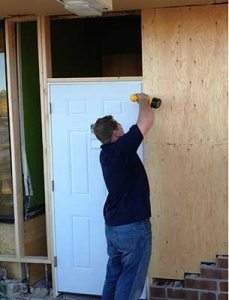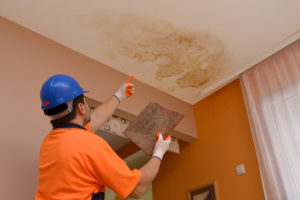What to Do After a Major Storm

A major storm can wreak havoc on your home or business. Whether you have been hit by flooding, a tornado, a hurricane, wind or hail damage, or some combination thereof, it is essential to know the steps to take after a storm.
Abbotts is available 24/7 for emergencies, call us now: 303-975-4000!
Safety First
The most important thing you can do directly following a major storm is keep yourself and your family safe. You may be dealing with a variety of unsafe conditions including:
- Downed power lines
- Structural instability in your home
- Holes in your roof or the sides of your home
- Broken windows and doors
- Standing water
- Exposure to toxins from sewage overflows or water from rivers or lakes
- Potential gas leaks
Take care to maintain your safety whether you are in the process of leaving your house or trying to remediate damages within it. Turn off the main gas line at the meter and turn off your electricity at the main power breaker, if possible. If there is any standing water, exercise extra caution. Electricity and water do not mix, and you should call an electrician if you do not feel safe to take these steps yourself.
Watch out for broken glass, and use a flashlight rather than a candle or other open flame if navigating through a dark house. Do what you can to safely leave your home if you suspect it is structurally unstable. And of course, always listen to the advice of your local law enforcement or fire safety professionals if they are making announcements.
Contact a Storm Damage Remediation Company ASAP
You may want to call your insurance company right away, but it is best to have someone on your side early on when it comes to insurance claims. You need someone to assess the damage and the best course of action who wants to bring your home to its pre-loss condition, rather than solely going off of your insurance adjustor’s assessment. A trusted storm damage remediation company like Abbotts Fire and Flood will act as the middleman between you and your insurance company, keeping you informed every step of the way.
You should find a storm damage repair company that can provide all necessary services, from board up to water damage restoration to mold remediation, as you may be dealing with a variety of damage as a result of the storm.
Protect Your Property from Further Damage

Board up all windows and doors and place a tarp over any exposed areas of your roof or siding. Most storm damage repair companies provide this service. You might also be interested in viewing this Video Blog on Storm Damage Recovery.
Document Everything
You may feel overwhelmed and writing things down and taking pictures or video of the damage may be stressful on top of it all, but it is important that you document every step of the way. In fact, if you know a big storm is coming, it is a good idea to take “before” pictures or video of your property and possessions. This will provide proof of the extent of the damages to your insurance company.
Take pictures of all of the damage you encounter (when looking for damage, as outlined in the next section). Get itemized receipts for any work you get done, as well as for any purchases you make as a result of being displaced from your home. Examples of such expenses are meals at restaurants (that you otherwise would have cooked at home) and hotel stays.
Examine Your Home for Damage
Particularly if you are waiting for your storm restoration company to arrive (or if you’re still deciding whether you will handle things on your own, or just bring a contractor in for part of the work), you should get started looking for and documenting damages. There are a variety of damages your home may have endured as a result of a major storm.
Roof and Exterior Damage
When looking for damage to the roof and exterior, look for:
- Granules from shingles in gutters or near downspout
- Missing, broken, bruised, dented, or cracked shingles
- Holes in roof
- Leaks in your ceiling
- Dents in gutters and other metal surfaces on roof
- Chips in paint and dents in metal facades
Flooding and Water Damage
O
Potential Toxins
You may not think of toxins as a type of damage, but these require professional remediation and should be documented along with other damage.
There are many potential toxins to keep an eye out for after a storm. If water has been standing for more than 24 hours, and particularly if it is warm or humid outside, mold spores may begin to grow. This can present a hazardous situation, and you should wear a protective respiratory mask if you suspect mold.
You should also be aware that sewage backup can occur during a number of types of severe storms. Sewage should not be handled by a layperson, and you should take extreme care to keep your family away from any exposed sewage.
If flooding occurred from any unclean sources (clean sources only include water that comes directly from your pipes or appliances before use), take similar care. This water could contain contaminants and needs to be handled by professionals.
Contact Your Insurance Company

Your homeowners insurance may or may not cover all types of storm damage repair. The most commonly excluded type of storm damage coverage is flooding. If you live in an area prone to flooding, you may want to consider purchasing flood insurance, if you do not have it already. Of course, if the damage has already occurred, you will need to figure out what the insurance you do have will and will not cover.
At Abbotts Fire and Flood, we stand on a foundation of more than 65 years of experience handling storm damage. We are available 24/7 in case of emergencies, and can help you navigate the tricky waters of insurance claims. Contact us today for a free consultation.

